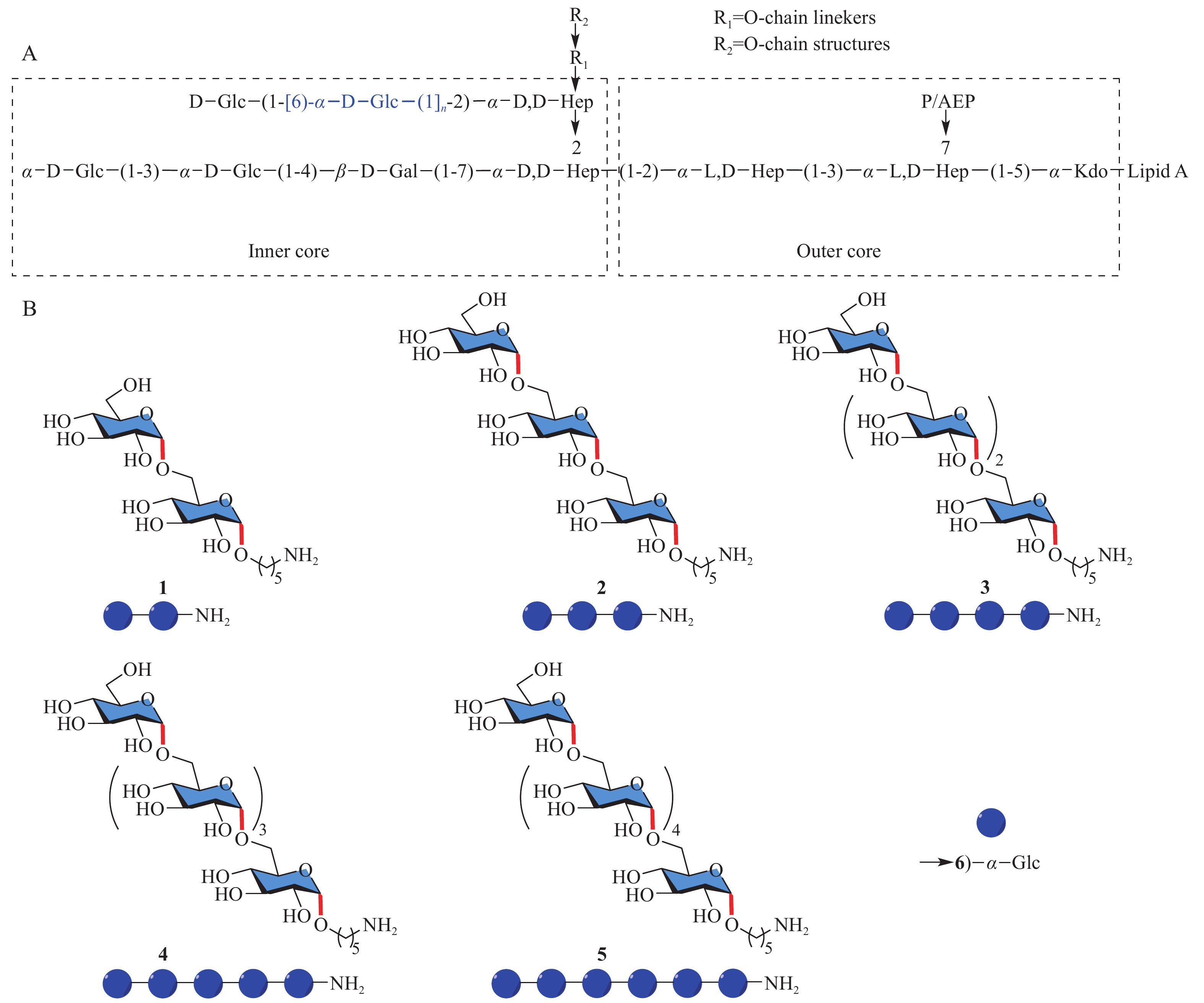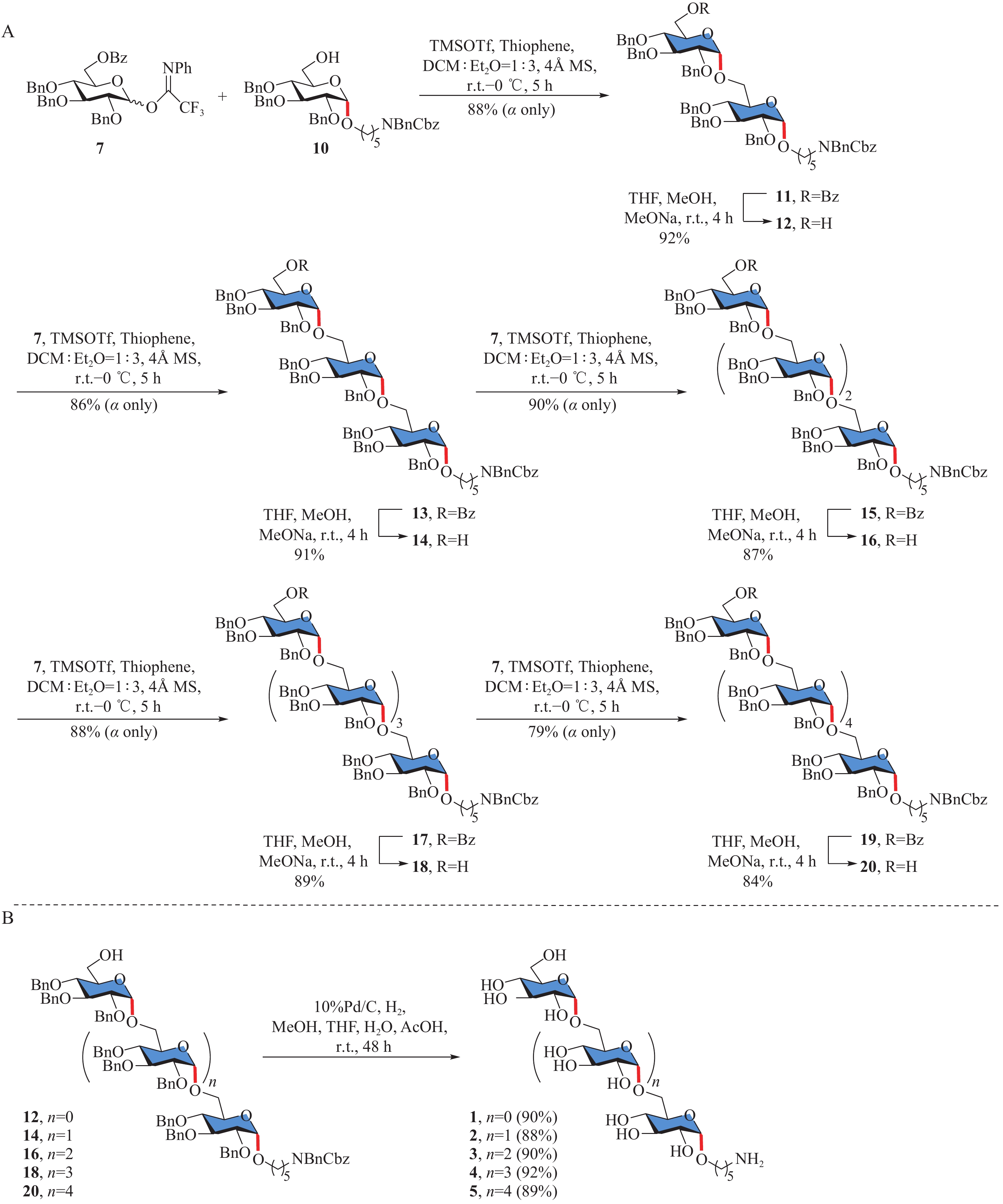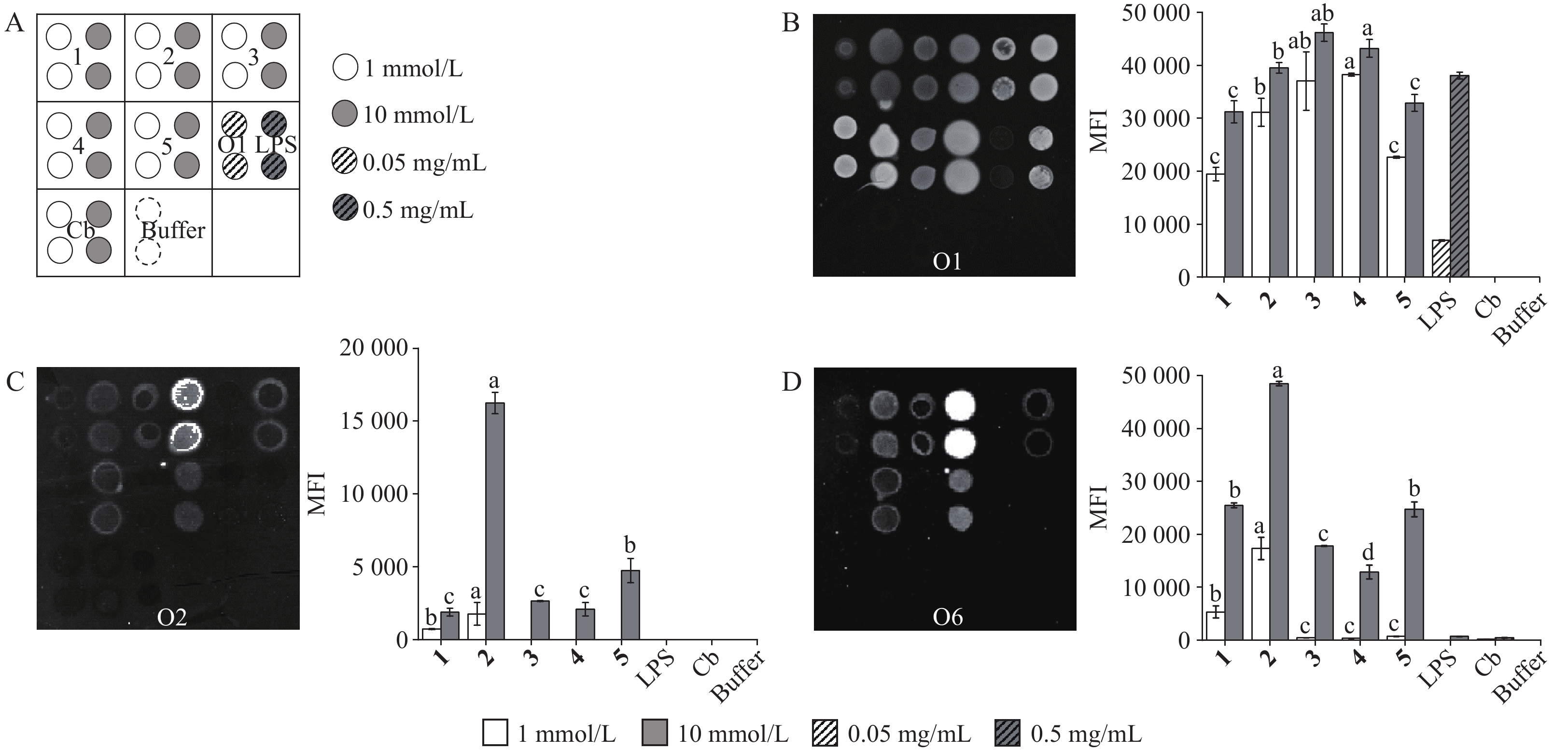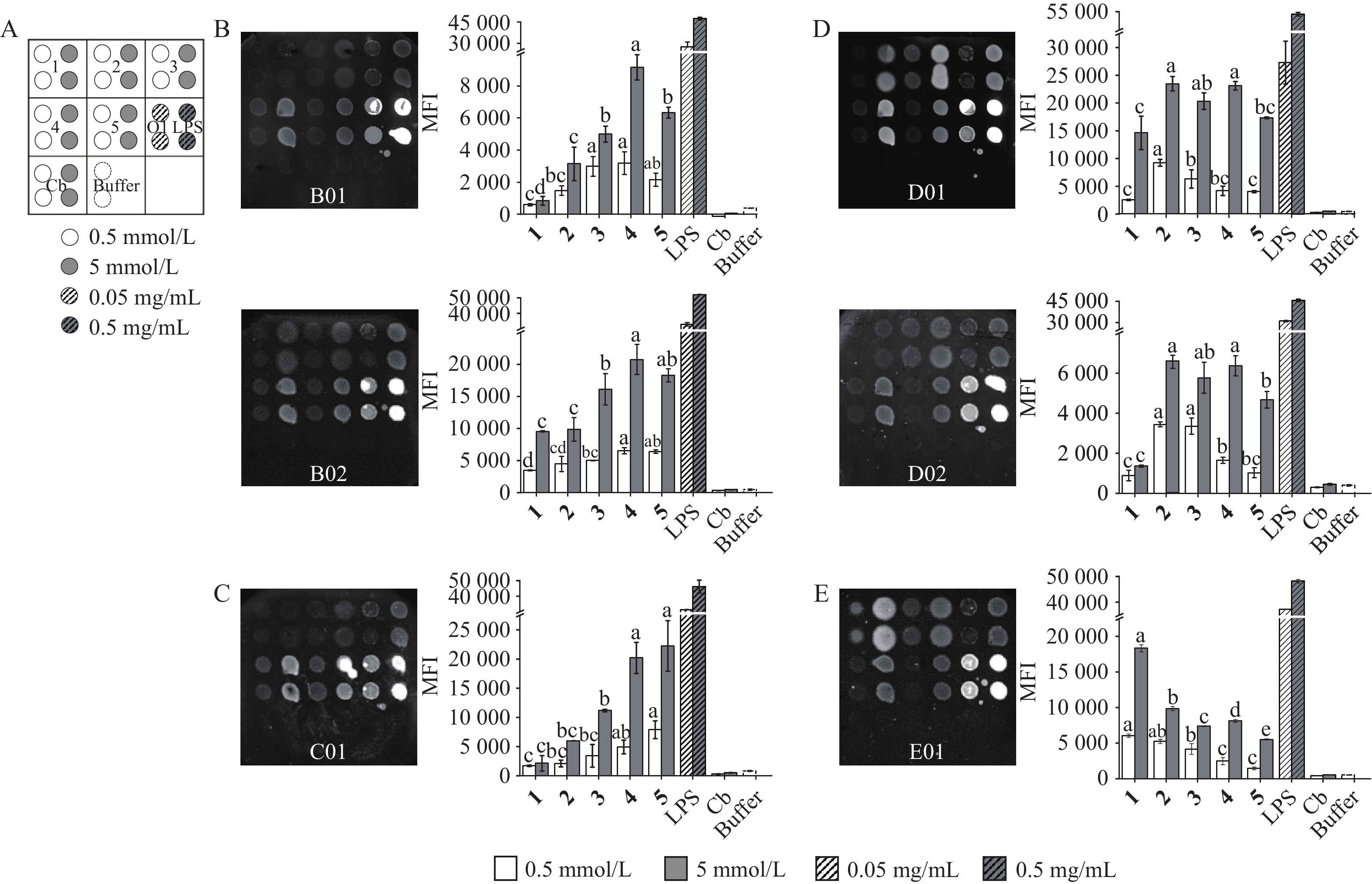Chemical synthesis and antibody affinity of epitope fragments from Helicobacter pylori lipopolysaccharide
-
摘要:
幽门螺杆菌(Helicobacter pylori, Hp)是引发慢性胃炎、消化性溃疡,甚至胃癌的重要致病菌,目前尚无上市预防或治疗Hp感染的疫苗。本研究通过化学法合成了Hp脂多糖核心寡糖中不同链长的α-1,6-葡聚糖片段(二糖至六糖),使用基于酰基远程参与作用和溶剂效应的协同糖基化策略成功构建了1,2-顺式-糖苷键。糖芯片筛选结果显示,脂多糖免疫兔血清和患者血清中的IgG抗体均能与合成的α-1,6-葡聚糖片段结合;脂多糖免疫兔血清IgG抗体与α-1,6-葡聚三糖具有较强的结合能力;绝大多数Hp感染患者血清IgG抗体能够很好地识别α-1,6-葡聚三糖和五糖,部分患者血清IgG抗体与α-1,6-葡聚二糖具有较强的结合作用。此研究结果表明,α-1,6-葡聚二糖、三糖和五糖可能是Hp脂多糖中的重要糖抗原片段。
Abstract:Helicobacter pylori (Hp) is responsible for chronic gastritis, peptic ulcers, and even gastric cancers. Currently, there is no vaccine to prevent or treat Hp infections. Here, we described the chemical synthesis of α-1,6-glucans with different lengths (di- to hexasaccharide), which are present in the core oligosaccharide of Hp lipopolysaccharide (LPS). The 1,2-cis-glucosidic bonds were constructed successfully using a synergistic glycosylation strategy based on acyl remote participation and solvent effects. The results of glycan microarrays indicated that all synthesized α-1,6-glucan fragments possessed a strong binding to IgG antibodies in both rabbit serum immunized with Hp O1 LPS and patient serum infected with Hp. The α-1,6-linked trisaccharide exhibited strong binding affinity to anti-LPS rabbit IgG antibodies. The α-1,6-glucan trisaccharide and pentasaccharide elicited a strong response to IgG antibodies in sera of most Hp-infected patients. Some patients’ sera exhibited strong binding activity with α-1,6-linked disaccharide. The results suggest that the α-1,6-glucan disaccharide, trisaccharide and pentasaccharide could be important carbohydrate antigen fragments in Hp lipopolysaccharide.
-
Keywords:
- Helicobacter pylori /
- lipopolysaccharide /
- α-1,6-glucan /
- glycan microarray /
- antibody affinity
-
-
Figure 1. Helicobacter pylori (Hp) lipopolysaccharide (LPS) and target oligosaccharides
A: General structure of Hp LPS(P:phosphate group; AEP:2-aminoethylphosphate; Glc:glucose; Gal:galactose; D,D-Hep:D-glycero-D-manno-heptose; L,D-Hep:L-glycero-D-manno-heptose; Kdo:3-deoxy-D-manno-octulosonic acid;n = 3–4 (average); B: Target α-1,6-glucans 1–5
Figure 2. Antibody affinity evaluation of synthetic α-1,6-glucans by glycan microarrays with Hp (serotype O1, O2, and O6) LPS immunized rabbit sera
A: Printing pattern. Samples: 1–5 (di- to hexasaccharide). Negative control: Cb (a synthetic Clostridium bolteae disaccharide, α-D-Manp-(1→4)-β-D-Rhap). Positive control: O1 LPS. Blank control: buffer. B-D: Representative array scan of Hp LPS immunized rabbit sera (dilution 1∶50) and quantification of mean fluorescence intensity (MFI) values of each oligosaccharide fragment. Error bars represent standard error of the mean (SEM) of two spots of two separate arrays. a, b, c and d represent the difference level between oligosaccharides 1–5 (P< 0.05). Different lowercase letters at the same concentration indicate significant differences
Figure 3. Antibody affinity evaluation of synthetic α-1,6-glucans by glycan microarrays with Hp-infected patient sera
A: Printing pattern. Samples: 1-5 (di- to hexasaccharide). Negative control: Cb (a synthetic Clostridium bolteae disaccharide, α-D-Manp-(1→4)-β-D-Rhap). Positive control: O1 LPS. Blank control: buffer. B-D: Representative array scan of Hp-infected patient sera (dilution 1∶20) and quantification of MFI values of each oligosaccharide fragment. Error bars represent SEM of two spots of two separate arrays. a, b, c and d represent the difference level between oligosaccharides 1-5 (P< 0.05). Different lowercase letters at the same concentration indicate significant differences
-
[1] Xu DY, Zhao SS, Dou J, et al. Engineered endolysin-based “artilysins” for controlling the gram-negative pathogen Helicobacter pylori[J]. AMB Express, 2021, 11(1): 63. doi: 10.1186/s13568-021-01222-8
[2] Xu WT, Xu LM, Xu CF. Relationship between Helicobacter pylori infection and gastrointestinal microecology[J]. Front Cell Infect Microbiol, 2022, 12: 938608. doi: 10.3389/fcimb.2022.938608
[3] Reyes VE. Helicobacter pylori and its role in gastric cancer[J]. Microorganisms, 2023, 11(5): 1312. doi: 10.3390/microorganisms11051312
[4] Lee YC, Dore MP, Graham DY. Diagnosis and treatment of Helicobacter pylori infection[J]. Annu Rev Med, 2022, 73: 183-195. doi: 10.1146/annurev-med-042220-020814
[5] Abdullah M, Greenfield LK, Bronte-Tinkew D, et al. VacA promotes CagA accumulation in gastric epithelial cells during Helicobacter pylori infection[J]. Sci Rep, 2019, 9(1): 38. doi: 10.1038/s41598-018-37095-4
[6] Shang Y, Zhao LY, Lu JK. Relationship between inflammatory cytokines and gastric cancer[J]. J China Pharm Univ (中国药科大学学报), 2015, 46(1): 123-128. [7] Lunn RM, Mehta SS, Jahnke GD, et al. Cancer hazard evaluations for contemporary needs: highlights from new national toxicology program evaluations and methodological advancements[J]. J Natl Cancer Inst, 2022, 114(11): 1441-1448. doi: 10.1093/jnci/djac164
[8] Graham DY. Transitioning of Helicobacter pylori therapy from trial and error to antimicrobial stewardship[J]. Antibiotics, 2020, 9(10): 671. doi: 10.3390/antibiotics9100671
[9] Matos R, Taillieu E, De Bruyckere S, et al. Presence of Helicobacter species in gastric mucosa of human patients and outcome of Helicobacter eradication treatment[J]. J Pers Med, 2022, 12(2): 181. doi: 10.3390/jpm12020181
[10] Jearth V, Rath MM, Chatterjee A, et al. Drug-resistant Helicobacter pylori: diagnosis and evidence-based approach[J]. Diagnostics, 2023, 13(18): 2944. doi: 10.3390/diagnostics13182944
[11] Dascălu RI, Bolocan A, Păduaru DN, et al. Multidrug resistance in Helicobacter pylori infection[J]. Front Microbiol, 2023, 14: 1128497. doi: 10.3389/fmicb.2023.1128497
[12] Imoto I, Yasuma T, D’Alessandro-Gabazza CN, et al. Antimicrobial effects of lactoferrin against Helicobacter pylori infection[J]. Pathogens, 2023, 12(4): 599. doi: 10.3390/pathogens12040599
[13] Dieye Y, Nguer CM, Thiam F, et al. Recombinant Helicobacter pylori vaccine delivery vehicle: a promising tool to treat infections and combat antimicrobial resistance[J]. Antibiotics, 2022, 11(12): 1701. doi: 10.3390/antibiotics11121701
[14] Xu XD, Ruan QP, Wu WT. Cloning of UreB from Helicobacter pylori and its expression in E. coli[J]. J China Pharm Univ (中国药科大学学报), 2004, 35(2): 183-186. [15] Friedrich V, Gerhard M. Vaccination against Helicobacter pylori - An approach for cancer prevention[J]? Mol Aspects Med, 2023, 92: 101183.
[16] Dos Santos Viana I, Cordeiro Santos ML, Santos Marques H, et al. Vaccine development against Helicobacter pylori: from ideal antigens to the current landscape[J]. Expert Rev Vaccines, 2021, 20(8): 989-999. doi: 10.1080/14760584.2021.1945450
[17] Zeng M, Mao XH, Li JX, et al. Efficacy, safety, and immunogenicity of an oral recombinant Helicobacter pylori vaccine in children in China: a randomised, double-blind, placebo-controlled, phase 3 trial[J]. Lancet, 2015, 386(10002): 1457-1464. doi: 10.1016/S0140-6736(15)60310-5
[18] Zhao Y, Arce-Gorvel V, Conde-Álvarez R, et al. Vaccine development targeting lipopolysaccharide structure modification[J]. Microbes Infect, 2018, 20(9/10): 455-460.
[19] Hulbert SW, Desai P, Jewett MC, et al. Glycovaccinology: the design and engineering of carbohydrate-based vaccine components[J]. Biotechnol Adv, 2023, 68: 108234. doi: 10.1016/j.biotechadv.2023.108234
[20] Nishat S, Andreana PR. Entirely carbohydrate-based vaccines: an emerging field for specific and selective immune responses[J]. Vaccines, 2016, 4(2): 19. doi: 10.3390/vaccines4020019
[21] Feng SJ, Xiong CH, Wang GR, et al. Exploration of recombinant fusion proteins YAPO and YAPL as carrier proteins for glycoconjugate vaccine design against Streptococcus pneumoniae infection[J]. ACS Infect Dis, 2020, 6(8): 2181-2191. doi: 10.1021/acsinfecdis.0c00260
[22] Meena J, Kumar R, Singh M, et al. Modulation of immune response and enhanced clearance of Salmonella typhi by delivery of Vi polysaccharide conjugate using PLA nanoparticles[J]. Eur J Pharm Biopharm, 2020, 152: 270-281. doi: 10.1016/j.ejpb.2020.05.023
[23] Qin CJ, Xiong DC, Yin J. Development of carbohydrate-based drugs driven by chemical glycobiology[J]. J China Pharm Univ (中国药科大学学报), 2024, 55(4): 429-431. doi: 10.11665/j.issn.1000-5048.2024071002 Qin CJ, Xiong DC, Yin J. Development of carbohydrate-based drugs driven by chemical glycobiology[J]. J China Pharm Univ (中国药科大学学报), 2024, 55(4): 429-431. doi: 10.11665/j.issn.1000-5048.2024071002
[24] Qin CJ, Tian GZ, Hu J, et al. Recent chemical synthesis and immunological evaluation of glycans related to bacterial lipopolysaccharides[J]. Curr Opin Chem Biol, 2024, 78: 102424. doi: 10.1016/j.cbpa.2023.102424
[25] Del Bino L, Østerlid KE, Wu DY, et al. Synthetic glycans to improve current glycoconjugate vaccines and fight antimicrobial resistance[J]. Chem Rev, 2022, 122(20): 15672-15716. doi: 10.1021/acs.chemrev.2c00021
[26] Sabnis A, Edwards AM. Lipopolysaccharide as an antibiotic target[J]. Biochim Biophys Acta Mol Cell Res, 2023, 1870(7): 119507. doi: 10.1016/j.bbamcr.2023.119507
[27] Britton S, Papp-Szabo E, Simala-Grant J, et al. A novel Helicobacter pylori cell-surface polysaccharide[J]. Carbohydr Res, 2005, 340(9): 1605-1611. doi: 10.1016/j.carres.2005.04.008
[28] Monteiro MA, Britton S, Applebee LA, et al. Synthesis and immunogenicity of a Helicobacter pylori lipopolysaccharide-based conjugate[J]. Vaccine, 2011, 29(17): 3098-3102. doi: 10.1016/j.vaccine.2011.02.063
[29] Harrison BA, Fernández H, Chandan V, et al. Characterization and functional activity of murine monoclonal antibodies specific for α1, 6-glucan chain of Helicobacter pylori lipopolysaccharide[J]. Helicobacter, 2011, 16(6): 459-467. doi: 10.1111/j.1523-5378.2011.00860.x
[30] Altman E, Chandan V, Harrison BA, et al. Chemoenzymatic synthesis of an α-1, 6-glucan-based conjugate vaccine against Helicobacter pylori[J]. Glycobiology, 2022, 32(8): 691-700. doi: 10.1093/glycob/cwac023
[31] Zou XP, Hu J, Zhao M, et al. Chemical synthesis of the highly sterically hindered core undecasaccharide of Helicobacter pylori lipopolysaccharide for antigenicity evaluation with human serum[J]. J Am Chem Soc, 2022, 144(32): 14535-14547. doi: 10.1021/jacs.2c03068
[32] Zhao QP, Zhang H, Zhang YX, et al. Stereoselective synthesis of a branched α-decaglucan[J]. Org Biomol Chem, 2020, 18(33): 6549-6557. doi: 10.1039/D0OB01402H
[33] Komarova BS, Tsvetkov YE, Pier GB, et al. First synthesis of pentasaccharide glycoform I of the outer core region of the Pseudomonas aeruginosa lipopolysaccharide[J]. J Org Chem, 2008, 73(21): 8411-8421. doi: 10.1021/jo801561p
[34] Zhang YQ, He HQ, Chen ZX, et al. Merging reagent modulation and remote anchimeric assistance for glycosylation: highly stereoselective synthesis of α-glycans up to a 30-mer[J]. Angew Chem Int Ed Engl, 2021, 60(22): 12597-12606. doi: 10.1002/anie.202103826
[35] Zou XP, Qin CJ, Pereira CL, et al. Synergistic glycosylation as key to the chemical synthesis of an outer core octasaccharide of Helicobacter pylori[J]. Chemistry, 2018, 24(12): 2868-2872. doi: 10.1002/chem.201800049
[36] Zhao M, Tian GZ, Qin CJ, et al. Immunological exploration of Helicobacter pylori serotype O2 O-antigen by using a synthetic glycan library[J]. Chin J Chem, 2024, 42(3): 243-251. doi: 10.1002/cjoc.202300510
[37] Tian GZ, Hu J, Qin CJ, et al. Chemical synthesis and immunological evaluation of Helicobacter pylori serotype O6 tridecasaccharide O-antigen containing a dd-heptoglycan[J]. Angew Chem Int Ed, 2020, 59(32): 13362-13370. doi: 10.1002/anie.202004267
[38] Ishiwata A, Tanaka K, Ao JM, et al. Recent advances in stereoselective 1, 2-cis-O-glycosylations[J]. Front Chem, 2022, 10: 972429. doi: 10.3389/fchem.2022.972429




 下载:
下载:




